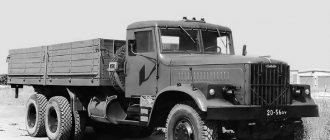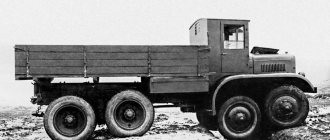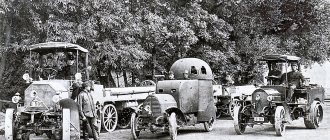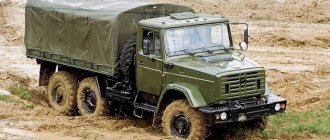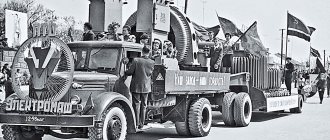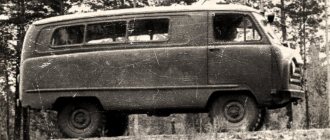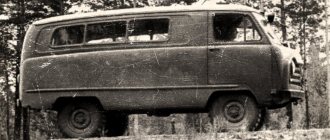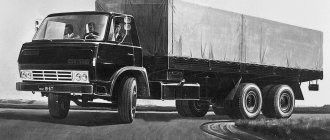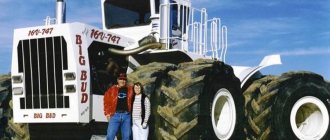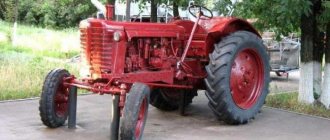Three-axle UAZs. This also happened
The car in the photo below is by no means homemade, as it might seem at first glance.
This is a prototype of the UAZ-452DG flatbed truck, manufactured by the Ulyanovsk Automobile Plant in 1976. What was this car? Along with an additional bridge, the “tadpole” received an extended frame and an enlarged cargo platform. Of course, it was necessary to modify the transfer case and install a new rear suspension - a balanced one, with springs from the UAZ-469. All innovations had a significant impact on the weight of the car, which increased to 2.45 tons. But the carrying capacity has almost doubled: instead of the required 800 kilograms for which the standard UAZ-452D was designed, the “three-axle” could already transport 1.5 tons.
When driving on asphalt in the UAZ-452DG, only the drive to the middle axle was engaged. By the way, it was very different from the serial “tadpole” rear axle: repressing the stockings made it possible to move the main gear reducer to the left of the longitudinal axis, freeing up space for mounting the intermediate support for the rear axle driveshaft.
But the front and rear axles could only be connected simultaneously: an additional flange for the rear axle driveline was connected to an extended drive shaft of the front axle.
By the way, in the 1970s, according to a similar “recipe,” a three-axle version of the UAZ-452V minibus was built at the plant. Being essentially a self-propelled prototype, this car, apparently, did not have its own index.
And the bottom photo shows the work of designer Guram Kvernadze, who headed the “Vezdekhod” cooperative. At the end of the existence of the Soviet Union, on the instructions of the Ministry of Health of the Georgian SSR, he built a medical ambulance with a 6x6 wheel arrangement on the basis of a UAZ-3741 van, designed for work in mountainous areas. The body of the “loaf” was lengthened by one section and an original high roof was installed on it. The car was named "Medea". It did not come to the point of mass production of such machines in newly independent Georgia.
Source
Comments • 11
the operator needs to break his hands.
By the way, how much would you rate it for?
What a miracle Yudo is this))) but when the video reached the cabin it turned me over))) the cabin is from the lawn))) usually a UAZ is assembled on a lawn chassis, but here it’s the other way around)))))
It was just an idea to create a small and passable dump truck for off-road work, and in my opinion we succeeded
Yes, the Ural is good, but its dimensions were not suitable for this area, and in connection with this, this project was born.
Good afternoon everyone, a small request to all subscribers and TV viewers, give a name to this project and this machine
There will be severe off-road driving on both projects
Is he on the move? Remove offroad
In ten days there will be both a three-suit and a tramp v 8 offroid
It’s just that two projects at once have been delayed because of this
Yes, yes, brother, he is on the move, purely painting work remains
thank you brother for your support, I still have 8 tramp on my channel. I’m currently assembling another car, can you tell me what I can use to put more wheels on it?
BODY
The entire cabin is cut around the perimeter - the edging is reinforced with the Livt-100mm profile The interior is sewn with aluminum The bumper was too lazy to make - I bought it at SPRUT Winch-Come UP 9500
Homemade author: Anton. Nizhny Novgorod.Source
UAZ-452 “Loaf”: hearse for nuclear war
This car was developed to transport corpses from a radioactive contamination zone, but today the “loaf”, having retained the design of the 50s, is an indispensable transport in the Russian outback. Let's analyze the phenomenon of an amazing car from the Ulyanovsk Automobile Plant.
The Empire Strikes
In the early 50s of the last century, it seemed that a nuclear war between the USSR and the USA could not be avoided. The post-apocalyptic future was perceived as almost inevitable, and the only question was who would best prepare for it. The Ulyanovsk Automobile Plant, which has been a “branch” for the production of GAZ-69 since the Second World War, on the eve of the almost beginning of the Third World War, receives a secret order from the Ministry of Defense: to develop a car for. removal of the wounded and dead from areas of radioactive damage.
Almost no one knows about this now, except for the few surviving developers of this car, but in an ordinary “loaf” with a van body, which you can often see on the streets, the possibility of transporting, in addition to the driver and passenger, five stretchers with the wounded was realized: four Of these, they are fastened along the sides in two tiers, and the fifth ones are pushed between the side ones. Marvelous? Doesn't seem true? Of course, these facts were strictly classified for many years!
MADE IN USSR
In the second half of the 50s, the understanding began to come that if there was an apocalypse, it would not necessarily be right now. It may happen tomorrow, but today an all-wheel drive car with a carriage layout, which is almost ready for production, would be very useful in everyday life. The car, which by this time had acquired the name UAZ-450, was based on a GAZ-69 chassis with an original body placed on top, drawn by designer V. I. Aryamov. They say factory testers started calling this car a “loaf”.
The vehicle could carry 800 kg of cargo and reach a speed of 90 km/h. In 1957, preparations for the production of this car were completed, and in 1958 its mass production began. Interestingly, two years earlier, a very similar car, the Ford FC, began to be produced in the United States. That car had two main variants, a truck with short and long cabs; the van appeared later and was produced in small numbers (like the model itself, which only survived until 1965), but the debate over the Soviet and American “loaves” has not subsided to this day. Did Aryamov steal the design from the Americans? It’s unlikely - the cars were drawn and developed at the same time (in full accordance with the canons of the “arms race”), it’s just that the Soviet one, as usual, was delayed in going into production. The point is not plagiarism, but the general design direction of those years - look, for example, at the first Volkswagen Transporter.
Second "loaf"
From 1958 to 1965, the “loaf” under the name UAZ-450 (the letter A was added to the index for an ambulance, B for a van and D for a truck with a wooden body) was produced in its original form: frame, 3-speed gearbox and gasoline a 2.1-liter engine producing 52 hp, all in its purest form from the GAZ-69 (the same engine, by the way, was installed on the GAZ-20 Pobeda). By the mid-60s, the car was made more technologically advanced, moving away from direct kinship with the army jeep: the curved welded frame was replaced by the original straight one made from a channel profile, lever shock absorbers gave way to telescopic shock absorbers, and the power unit was borrowed from the GAZ-21 Volga - an overhead valve 2.5-liter 70-horsepower engine was mated to a 4-speed gearbox. In addition, the layout of the power unit and steering has been optimized.
At the same time, the car also received a “facelift” - the design of the front part of the cabin in the form in which we know this car now. In 1965, the modernized UAZ-452D truck went into production (it received the apt nickname “tadpole” among the people); a year later, other modifications followed: the UAZ-452 van, the UAZ-452A “nurse” (it was nicknamed the “tablet” or “ pill"), and the ten-seater minibus UAZ-452V, which appeared for the first time in the range. By the way, according to one version, this modification, “too civilian” and expensive for the UAZ of those years, was born almost by accident - people from Autoexport, an organization that sold Soviet cars abroad, insisted on it. Although the “minibus” option was included in the first sketches!
Variations
“Loaf” is a Soviet car that holds the record for the number of modifications and “tuning versions.” This is due to two factors: a) the car turned out to be very successful and in demand; b) UAZ had a strong focus on the army and at the same time very modest production capacities. Modifications can be divided into two large groups: those made by third-party organizations and those made by UAZ itself. The first group, numerous options for “non-factory tuning,” were generated mainly by the long absence of a minibus in the range - auto repair and mechanical plants converted vans into buses, cutting in windows and installing seats. Such cars, nicknamed “barbuhaikas,” were deprived of normal ventilation, heating and even entry and exit, but the situation was saved.
And what’s more, the “barbuhayki” provoked the development of a whole new branch of the Soviet automobile industry: over time, quite decent minibuses began to be produced on the “loaf” chassis, sometimes even superior to the factory UAZ-452V in comfort - such, for example, were the minibuses of the APVU (Pskov Automobile Repair Plant ). And then the same factories began assembling specialized vehicles on the same proven platform - this is how film moving vehicles (), cars for filming (Chernigov Special Vehicle Transport Plant) and even land reclamation equipment (Pskov) appeared. As for UAZ’s own research, the engineering staff generated a simply gigantic number of all kinds of prototypes, and what a pity that most of them did not find a place on the assembly line: an ambulance with soft hydropneumatic suspension, a resuscitation vehicle for rescuers, a 16-seater bus , crawler all-terrain vehicle, truck tractor.
Source
UAZ-452: technical characteristics
Twice Red Banner all-terrain vehicle with a “bread” nickname
UAZ-452 is an all-wheel drive off-road utility vehicle, which was mass-produced by the Ulyanovsk Automobile Plant from 1965 to 1985. In popular usage, this car was nicknamed “tadpole” (flatbed truck); “loaf” (van and minibus), “tablet” (minibus “nurse”). The history of the car did not end in the 80s, nor in the 90s, nor even in the 2000s. Having received several upgrades and new ones, “Loaf” continues to be produced today.
Over the past couple of decades, “Loaf” has been “retired” several times. However, the demand for an unpretentious, cheap, universal and, most importantly, all-terrain vehicle in the vastness of our Motherland, especially in the outback, is so great that the decision to continue the production of vehicles of the UAZ cargo-passenger family was made again and again. As a result, the UAZ-452, together with its subsequent modifications, became the record holder - the oldest Soviet/Russian car in terms of the number of years of serial production.
Story
Cars manufactured 1965–1979 They were equipped with old-style lights: the direction indicators were colorless (white), the rear lights were round, and the rear part of the body was more rounded. Subsequent models after 1979 received amber (yellow) signal lights, and the taillights were slightly larger and rectangular.
In 1985, the van was modernized and separated into separate sub-models: 39625, 3962, 3303, 3909 and 2206. The modernization included lighting fixtures that meet modern international requirements, an alarm system, a new instrument panel and a new speedometer. The brakes have been redone. The engine has also been upgraded and its power output has increased to 99 bhp. with 78 hp
In the early 2000s, the model received new plastic side mirrors taken from the GAZ Gazelle van, headrests on the front seats; and new passenger seats for the minibus version ( 2206
) also received headrests. The pickup truck (version 3303) received a metal body instead of a wooden one.
In subsequent years the engine was upgraded to meet modern emissions requirements and the van was also fitted with a plastic steering wheel to reduce injuries.
In March 2011, the 39625, 3962 and 2206 received updates that included ABS brakes, power steering, seat belts and a Euro 4 engine as standard equipment.
| old side mirror (pre-2000s) | new side mirror (post 2000s) |
UAZ-452: features and history of the model
The predecessor of the UAZ-452, the design of which the Ulyanovsk plant specialists relied on when developing the new model, was the classic Soviet SUV GAZ-69. The universal version of this car was equipped with an eight-seater body with two side doors and a folding tailgate. Three-seat lifting benches were installed along the side sides. A stretcher was provided for transporting the wounded, and the vehicle was equipped with a towing device.
At the end of the 50s of the twentieth century, designers were given the task: on the basis of the GAZ-69, to create a larger and more load-bearing universal cargo-passenger chassis for mass production of both flatbed trucks and all-metal vans with a “wagon” layout. Both versions had to have good cross-country ability.
Ulyanovsk already had successful experience: by this time, new UAZ-300 and UAZ-302 vehicles had passed road tests. These gasoline trucks, equipped with a 50-horsepower Pobeda engine and a four-speed gearbox, were the original development of the famous lorry.
By 1958, on the extended base and chassis of the GAZ-69, using the main components of this SUV, all-wheel drive vehicles of the UAZ-450 series were built, tested and put into production. They appeared in three versions: van, ambulance and flatbed truck. The UAZ-450 was equipped with a lower-valve GAZ engine with a volume of 2,432 cm 3 and a power of 62 hp. (45 kW). The length of the vehicle was 4.3 m. The curb weight was 1.65 tons. The load capacity was 0.8 tons. The speed on the highway was 90 km/h.
The new series was further developed in UAZ-451 cars, which had only one drive axle (rear-wheel drive). Their carrying capacity was increased to 1.0 tons. These vehicles were equipped with a more powerful overhead valve engine of the Ulyanovsk plant’s own design and an improved four-speed gearbox.
The external design of the cabin was changed: it acquired features that are now familiar to everyone in the CIS and beyond. The “nostrils” were replaced with the same radiator grille that has survived to this day. The rear-wheel drive UAZ-451, which was subsequently produced for several years in parallel with the UAZ-452, was also produced in three modifications: a van; ambulance and truck with a double cabin and a wooden body.
In 1965, the UAZ-450 was significantly modernized. The body received a side door, turning the cargo van into a cargo van, with a double door at the rear. Depending on the modification and purpose (ambulance vehicle, postal van, etc.), the configuration of the doors also changed slightly. The engine and transmission of the car were also improved. This is how “the one,” the legendary UAZ-452, appeared.
In 1966, the UAZ-452D (tadpole flatbed truck) was awarded a gold medal at the Moscow International Agricultural Equipment Exhibition. And on August 20, 1966, the Ulyanovsk Automobile Plant received the Order of the Red Banner of Labor from the party and government for the successful development of mass production of a much-needed family of cars in the national economy.
In 1974, on February 18, the millionth UAZ car rolled off the production line of the enterprise. It became a “loaf” - a UAZ-452 cargo van. A couple of years later, on February 16, 1976, the plant was awarded the second Order of the Red Banner, in particular, for a new successful model - the UAZ 452V - a universal 10-seater minibus. In November 1977, the UAZ-452 family was awarded the All-Union Quality Mark.
The currently produced “loaves”, “tablets” and “tadpoles”, while maintaining their external patriarchal appearance, are already equipped with a modern injection engine that meets Euro-4 standards, ABS, and power steering. But the last one, the UAZ-452, came off the production line in 1985, and all its subsequent descendants were called by other indices.
external reference
- UAZ official website
- Official website UAZ-452
UAZ chronology, 1980s - present | |||||||||||||||||||||||||||||||||||||||
| Type | 1980s | 1990s | 2000s | 2010s | |||||||||||||||||||||||||||||||||||
| 0 | 1 | 2 | 3 | 4 | 5 | 6 | 7 | 8 | 9 | 0 | 1 | 2 | 3 | 4 | 5 | 6 | 7 | 8 | 9 | 0 | 1 | 2 | 3 | 4 | 5 | 6 | 7 | 8 | 9 | 0 | 1 | 2 | 3 | 4 | 5 | 6 | 7 | ||
| SUVs | UAZ Simbir | ||||||||||||||||||||||||||||||||||||||
| UAZ-469B | UAZ-31512 | UAZ Hunter | |||||||||||||||||||||||||||||||||||||
| UAZ Patriot | |||||||||||||||||||||||||||||||||||||||
| Vans | UAZ-452 | ||||||||||||||||||||||||||||||||||||||
Technical characteristics of UAZ-452
UAZ-452 cars have a frame structure, are equipped with two drive axles and a manual gearbox with a range-shifter (with the ability to switch all “speeds” to a reduction mode). The design of the car for those distant years became innovative in the domestic automobile industry - the layout of the “curbover” van, that is, “engine under the cab,” was first used on a Soviet production car in the UAZ-450-UAZ-452 family.
Mass-dimensional parameters of a production car
- Length: 4,440-4,474 m (depending on modification); Width: 2,100 m; Height: 2,355 m.
- Wheelbase: 2,550 m.
- Ground clearance: 220 mm.
- Front and rear track: 1,442 m.
- Weight: from 1,845 tons to 1,909 tons (depending on modification)
- Gross weight: from 2,730 to 3,070 tons (depending on modification).
Engines UAZ-452 and modifications
Four-cylinder carburetor gasoline engine UMZ-451 with a displacement of 2.5 liters. Produces 72 horsepower at 4000 rpm and 156 Nm of maximum torque at 2500 rpm.
Four-cylinder carburetor gasoline engine UMZ-4213 with a working volume of 2.89 liters and a power of 72 horsepower. Maximum torque: 201.0 Nm in the frequency range from 3000-3500 min. Engine capacity: 2445 cm3 Cylinder diameter: 92 mm: piston stroke: 92 mm. Compression ratio: 6.7.
Four-cylinder carburetor gasoline engine UMZ-414 with a working volume of 2.445 liters and a power of 90 horsepower. Maximum torque: 181.4 Nm in the frequency range from 2200-2500 min. Cylinder diameter: 92 mm; piston stroke: 92 mm. Compression ratio: 6.7.
In subsequent modifications after 1985:
Four-cylinder carburetor gasoline engine ZMZ-402 with a working volume of 2.445 liters, a power of 98 horsepower at 4000 rpm. Maximum torque: 156 N•m, at 2500 rpm. Bore: 92 mm: Stroke: 92 mm. Compression ratio: 8.2.
Four-cylinder carburetor gasoline engine ZMZ-4091 with a displacement of 2,700 liters, power of 112 horsepower, at 4000 rpm. Maximum torque: 208 N•m, at 3000 rpm. Bore: 95.5 mm: Stroke: 94 mm. Compression ratio: 9.
Now the descendants of the UAZ-452 are equipped with a modern injection engine ZMZ-409 .
On the Internet you can often find discussions on the topic: Which engine is better for a UAZ? Experienced drivers and UAZ owners agree that the previous UMZ carburetor engines, for all their inefficiency and environmental friendliness, were still better suited for real harsh off-road conditions: “Why argue? What engine can be brought in after the car is flooded? Which engine is easier to repair on your knees in the forest? Which engine has better low speed thrust? Which engine is less picky about fuel quality? UMZ!
Many people also call the independent installation of a GAZ-53 clutch on a UMP engine a big plus on brutal off-road conditions: “The clutch becomes almost indestructible. Due to the greater mass of the clutch, engine torque increases.”
Suspension, transmission and brakes of the UAZ-452
The overall design of the car's transmission and suspension has remained virtually unchanged over all these years of production. And this is not due to the plant’s reluctance to change anything in the old model or improve it, but to the same notorious ideal geometric cross-country ability of the UAZ.
Both front and rear the car uses a dependent suspension based on continuous axles, which ensures maximum preservation of ground clearance during any strong rolls and overcoming obstacles (for example, large stones).
Rear suspension - dependent, spring (on longitudinal semi-elliptic springs). The ends of the springs are installed in rubber cushions. Shock absorbers - hydraulic, lever, double-acting. Installed on the front and rear axles.
The frame of the UAZ-452 is stamped from sheet steel, longitudinal beams of a channel section connected by six cross members. Front and rear brakes are of drum design. The brake drive is hydraulic - from a suspended pedal, shoe with a drum, mechanical drive - by a cable from a lever.
The UAZ-452 is truly excellent for off-road use. Its arsenal includes a 2-speed transfer case, front-wheel drive, solid ground clearance and excellent cross-country ability. In terms of cross-country ability, it is still many times superior to modern SUVs.
The gearbox on the UAZ is mechanical, three-way, with four forward gears and one reverse. The transfer case is gear-type, with two gears. The cardan transmission consists of two tubular open cardan shafts - rear and front.
The front axle is stamped, I-section. The main gear is single, a pair of bevel gears with a spiral tooth; gear ratio 5.12. The differential is conical, with four satellites.
Cabin of UAZ-452
The cabin is all-metal, double, with two side single-leaf doors and a removable engine hood cover. The cabin is designed for a driver and one passenger, whose seats are located on the sides of the engine. The motor, covered with a lid and casing, is located directly in the middle of the cabin.
In our “plastic” age, the interior of the UAZ-452 looks like a museum exhibit, like a small “journey into the past.” And people find a distinctive aesthetic in it, like many vintage cars. This effect of an “excursion into the last century” is felt even more in the interior of the UAZ-452 of the 60s/70s (which still had a “line” of instruments from the “Victory”).
The spartan interior of the UAZ is also very practical; it is convenient for difficult road conditions, rural areas, and the army. Metal panels can be quickly cleaned of anything. And the floor can be easily washed with a stream from a hose, or by splashing a couple of buckets of water on it.
Recommendations
This article is taken from Russian Wikipedia.
- https://www.uazbuka.ru/models/gal450.htm
- “Russian UAZ just came up with the toughest transfer van ever.” Hagerty Media
. 2020-02-05. Received 2020-10-26. - https://uaz.rustina.cz/LITERATURA/KATALOG_NAHRADNICH_DILU_3741.pdf Spare parts catalog page 53
- Thompson, Andy. Cars of the Soviet Union
(Haynes Publishing, Somerset, UK, 2008), p.178. - De Agostini
Autolegends of the USSR [1] (Autolegends of the USSR). UAZ-452 Moscow ISSN 2071-095X - "Archival copy." Archived from the original on 2009-06-15. Retrieved 2009-06-08.CS1 maint: zipped copy as title (link)
Reviews from drivers and owners about UAZ-452 cars
Let's start with the machine's shortcomings, which are often noted by both experienced people and just outside observers. The first negative that immediately catches your eye is the lack of comfort in the cabin. In this regard, the leitmotif of most reviews of all drivers and owners about the car is as follows. In general, you need to understand that the UAZ-452 is a product of the domestic automobile industry, and it is far from a new product, but rather an antique. You just need to accept this fact and not try to treat the 452nd UAZ as a foreign car, and it is useless to compare it with foreign cars.
The UAZ-452 is a fairly simple, utilitarian car, in which there is not even a hint of comfort, but which will go where even the coolest and most modern SUVs will be powerless. The following significant disadvantages of this car are high fuel consumption and danger to the legs, and even the life of the driver in the event of a head-on collision.
In the Soviet Union, however, these problems were not of particular importance: there were no problems with cheap gasoline, and accidents were rare, due to the small number of cars on the roads and the lack of such high speeds as we have now.
Yes, many people note that the UAZ-452 is reliable and trouble-free only during the first years of its operation, then it will no longer be possible to be just a driver, and willy-nilly you will have to become familiar with all the technical features of the car’s design in practice. However, serious breakdowns are still rare, even on older UAZs. Problems arise mainly from small things.
The advantages of the UAZ-452 are also quite obvious. These are excellent maneuverability, extreme ease of operation and maintenance, unpretentiousness and maintainability. Most repair operations can be done quite easily in any garage, using available tools. Or even just - in a field or forest.
The UAZ-452 is praised not only for its cross-country ability. The driver of a compact UAZ, no larger than a passenger car, clearly feels its dimensions. Thanks to the short wheelbase, the turning radius is very small.
Another significant advantage of the car is its versatility. The interior of a passenger or cargo “loaf” provides truly enormous opportunities for transformation, alteration and tuning. Some owners are not limited to the standard folding table, quick-release (with a screwdriver) stools and a rear sofa. And they turn their UAZ into a real “home on wheels”, in which it is very pleasant to travel, go on picnics, hunt or fish.
There are also a lot of options for insulating a UAZ and making it excellent sound insulation. You can use any material you like. The secret of the long-term popularity of the “loaf” is also in the cheapness of this car, which is successfully combined with simplicity.
The UAZ “Bukhanka” is often subject to tuning due to the low cost of the base – the car itself. As a result of the inspired creativity of the owners, such new versions of the old nickname as “BooHammer” or “BooHunter” appear.
NHẬN XÉT • 11
the operator needs to break his hands.
By the way, how much would you rate it for?
What a miracle Yudo is this))) but when the video reached the cabin it turned me over))) the cabin is from the lawn))) usually a UAZ is assembled on a lawn chassis, but here it’s the other way around)))))
It was just an idea to create a small and passable dump truck for off-road work, and in my opinion we succeeded
Yes, the Ural is good, but its dimensions were not suitable for this area, and in connection with this, this project was born.
Good afternoon everyone, a small request to all subscribers and TV viewers, give a name to this project and this machine
There will be severe off-road driving on both projects
Is he on the move? Remove offroad
In ten days there will be both a three-suit and a tramp v 8 offroid
It’s just that two projects at once have been delayed because of this
UAZ-"loaf" abroad
It’s hard to believe, but even in the 21st century, UAZ “loaves” continue to be exported, and not only to the former Soviet republics and socialist countries. For example, right-hand drive UAZs continue to be supplied to Japan today, just as in Soviet times. There, a loaf costs 20 thousand dollars. It seems that in the Land of the Rising Sun there are no other chances to buy a new car that will be so simple and not “stuffed with electronics.”
Among the countries of Western Europe, the “loaf” gained the greatest popularity in Italy. In this country there are several clubs of fans of this car, which have united into an association. This association is responsible for a raid on “loaves” across the Sahara Desert with a length of 11 thousand kilometers; motor rallies "Rome - Moscow" and "Rome - Ulyanovsk", rally in Iceland - a distant and wild country of volcanic geysers.
In 2001, the popular feature film “The Last Kiss” was released in Italy. According to the plot of the film, three friends dream of making a house on wheels out of a UAZ and traveling around the world in it, bringing their ideas of freedom to life. At the end of the film, however, they sell it.
Price UAZ-452
The price of a new UAZ “tadpole” (flatbed truck) currently starts, according to the official website of the Ulyanovsk Automobile Plant, at 399,000 rubles. Directly from the factory, the cargo version can be purchased equipped with arches and an awning; or by a food or manufactured goods van; a special van for transporting bakery products, price negotiable.
A new UAZ “loaf” costs from 437,000 rubles. Modification of the UAZ-39094 Farmer (with an extended cabin, two rows of seats, and a tilt side body) - from 480,000 rubles.
On the Internet you can find a great many advertisements for the sale of used UAZ-452 of various modifications. Such offers are found in almost every region of our country, due to the huge prevalence of cars of this brand. Prices for a used UAZ-452 vary widely, depending on the year of manufacture, technical condition, and sophistication of tuning - from 25,000 to 200,000 rubles.
Indeed, there are a lot of much more modern minibuses, capable of providing the driver and passengers with comfort that differs by several orders of magnitude from the UAZ minibuses. However, in terms of cross-country ability/price/capacity, the “loaves” still have no competitors. By the way, for the same reason, for example, they continue to produce the same “antediluvian” Defender.
Source

